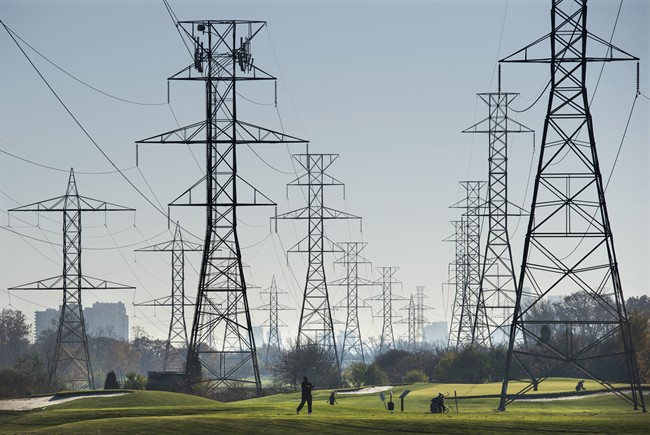In the early morning hours of March 13, 1989, Christine Gombas thought the world was ending.

The then-52-year-old was at her home in rural Quebec, her son glued to the family’s television, when the power blinked out.
“The house made a funny noise, like a hum,” Gombas told a reporter from The Montreal Gazette the next day.
“When I looked out the window, the whole sky was in stripes … I’ve never seen anything so unusual.”
What she — and anyone else still awake at that hour in Quebec — saw was a solar storm hitting the Earth’s upper atmosphere. Within minutes, Hydro Quebec’s highly inter-linked electrical grid collapsed, plunging the province into darkness as temperatures dipped to -15 C.
In 1989, the hours-long loss of electricity was inconvenient, costly and potentially dangerous. But the storm that struck Earth that night was nothing compared to the one that hit us over a century earlier, in the late summer of 1859.
The so-called Carrington Event lit the sky so brightly that people could read newspapers by the aurora it generated. It blew out telegraph systems all over the globe. More than a few telegraph operators got a nasty shock.
Today, a similar event would be catastrophic. Electrical distribution networks could theoretically be blown out across Canada, with some experts predicting that blackouts would last anywhere from weeks to over a year.
We narrowly escaped a storm of this magnitude in 2012, and were saved only by the fact that it passed through Earth’s orbit when Earth wasn’t there. NASA estimates that the chance of a storm like that hitting us is about 12 per cent per decade.
WATCH: Intense storm narrowly misses Earth
A growing chorus of experts are warning that those odds are worrisome, considering the potential consequences. And they’ve also been flagging the possibility that humans could themselves generate an electromagnetic pulse (EMP) capable of producing a similar, continent-wide blackout.
While the Canadian government is aware of these dual threats to our electrical grid, it’s unclear what concrete steps have been taken to protect it.
A nuclear explosion could trigger an EMP — and blackout
“The threat from the sun is inevitable,” said Dr. Peter Pry, author of Blackout Wars, CIA veteran and current executive director of America’s EMP Task Force on National and Homeland Security.
“It guarantees that in our lifetimes, or those of our children, we’re going to get hit by one of these things.”
But Pry is perhaps more concerned by the threat of a man-made EMP pulse, originating hundreds of kilometres above our heads.
The detonation of a nuclear bomb at high altitude (300-400 kilometres) could, in theory, cause the same kind of electrical overloads and meltdowns on the ground as a solar storm.
A Congressional commission in the United States studied this terror threat extensively in the mid-2000s, and concluded that while the blast itself probably wouldn’t kill anyone, lengthy blackouts — if they were to occur — could kill millions as a result of starvation, exposure or societal breakdown.

Pry and others, including former CIA director R. James Woolsey, have been sounding the alarm since details surrounding the threat of a nuclear EMP were first declassified by the U.S. government a decade ago.

Get breaking National news
Last April, Pry made his way north, where he and another expert, Cynthia Ayers, testified before the Standing Senate Committee on National Security and Defence in Ottawa.
He warned the Canadian senators that several nations, including Russia, China and North Korea, already have the technical know-how to mount such an attack against the U.S., and Canada could easily become collateral damage. Our electrical grids are, after all, interlinked.
The nuclear warhead could be attached to a satellite, the theory goes, and flown on a south-polar trajectory that evades U.S. early warning systems and defences. Pry also told the committee that North Korea and Iran have reportedly practiced using a short-range missile launched off a freighter to carry out an EMP attack.
“I was very encouraged. I thought they listened and heard us out, especially since this is probably the first time that they were being exposed to this information,” Pry said of his Canadian appearance.
“They seemed to take it seriously … I don’t know what their follow-up has been.”
Is Canada prepared for the ‘inevitable’? We don’t know
The Canadian government is certainly aware of the EMP threat, and has seemingly begun doing something about it. But details are sketchy, at best.
According to Public Safety Canada spokesperson Karine Martel, a series of “guidelines” for confronting an EMP pulse or major solar storm have been established for the owners and operators of Canada’s electrical grid (these would include hundreds of utilities like Hydro Quebec and Ontario’s Hydro One), local governments and other stakeholders.
These guidelines were also referenced, but not listed, in documents obtained by Global News last summer through Access to Information legislation.
The guidelines themselves are only available though the department’s Critical Infrastructure Gateway, which is not publicly accessible.
“The guidelines share best practices and challenge assumptions as to Canada’s level of preparedness to respond to these unique events,” Martel wrote in an emailed response to questions from Global News.
Over at Natural Resources Canada, research into so-called “space weather” has been ongoing.
There are a few established technologies that Pry and others have argued could immediately help “harden” the North American grid against the effects of an EMP attack or Carrington-level solar event. These include Faraday cages (used to block electric fields) and surge protectors on high-voltage electrical transformers.

Pry compares the surge protectors to the bulky additions on the plugs we use for our computers.
“It’s basically the same kind of technology scaled up,” he said.
Public Safety Canada’s guidelines for industry don’t “speak specifically to the use of surge protectors or other technology,” according to Martel. But they do “outline actions that can help minimize the impact of these disasters.”
Meanwhile, the U.S. Department of Defense is using nature itself to keep its equipment safe. Last year, the Pentagon confirmed that it was moving the headquarters for the North American Aerospace Defense Command (NORAD) back underground at Cheyenne Mountain in Colorado.
NORAD Commander Adm. William Gortney explained that the move made sense, given that “because of the very nature of the way that Cheyenne Mountain’s built. It’s EMP-hardened.”
Some of the recommendations from the EMP commission in 2008 included better training for repair and recovery teams, simulating and practicing the response to an EMP blackout, expansion of emergency power supplies and the establishment of “micro-grids” that could be repaired or operated independently if the broader grid collapsed.
- Canadian woman charged with illegally crossing into U.S., kicking border agent’s face
- A new ‘cold’ war? Canada looks to bolster Arctic security, sovereignty
- Canadian furniture industry still ‘reeling’ after Trump pauses tariff spike
- Ottawa propose fines of up to $1M for violating foreign influence registry rules
Are calls for more attention to EMPs alarmist?
Pry and others may be ringing alarm bells over the vulnerabilities in the North American electrical grid, but their warnings have generated skepticism from some quarters.
It has been suggested, for example, that the logistics of getting a nuclear device into the high atmosphere and detonating it at a precise altitude are prohibitive, and that no nation state in its right mind would launch such an attack given the United States’ ability to respond in kind.
Others have questioned the science behind the man-made, massive-blackout scenarios, suggesting more study is needed.
In spite of his extensive expertise, Pry himself has also been the subject of criticism. During his Senate appearance, he was questioned about his personal beliefs about climate change, a risk to human safety that he does not outright deny, but feels needs to be studied by a congressional or presidential commission.
According to Dr. Luis Marti, director of reliability studies, standards and compliance at Ontario’s Hydro One, Canada is ahead of the curve when it comes to solar storms, at least.
There are early warning systems in place to alert authorities if ‘The Big One’ is coming, he explained. Observation of ‘sun spots’ could give us more than a day’s warning.
Scenarios like one from the U.S. National Academy of Sciences that predict 300 or more high-voltage transformers could fry out simultaneously — taking down the bulk of the electrical grid for months or even years — are “physically impossible,” according to Marti.
“If this were the mother of all storms, you batten down the hatches, power down gracefully and start again in an hour or two,” Marti said, adding that if a transformer starts to overload, the voltage will drop and the system will effectively protect itself.
“Having said that, transformers fail. If a transformer is in bad shape, for whatever reasons, some odd pieces of equipment can be damaged. But nothing compared to the gloom-and-doom scenario.”
As for an EMP terror attack from high altitude, Marti said his preliminary calculations have indicated that “it will not automatically kill a transformer. That’s (based on) very limited calculations that I did a couple of years ago.”
More research is now underway. The Electric Power Research Institute is currently undertaking a massive three-year study of the possible vulnerabilities to a major EMP attack, Marti said, and he has shared his work with them.
“They’re going ahead and doing more detailed calculations,” he said.
Marti also noted that as they assess the threat, governments and stakeholders should pay careful attention to who is urging them to invest in protective equipment. In some cases, he warned, groups and individuals stand to make a profit from these sales.
Regulators and utilities left to fend for themselves
For now, there isn’t much high-level movement from the American and Canadian governments. They have largely left industry regulators and utilities to fend for themselves.
In early December, however, the two countries released a new Joint Canada-United States Electric Grid Security and Resilience Strategy, designed to “strengthen the security and resilience of the U.S. and Canadian electric grid from all adversarial, technological, and natural hazards and threats.”
The strategy, which is not legally binding, makes no specific mention of EMP, but it does state that the two countries will continue working to “protect and harden existing features of the electric grid, to identify and mitigate system-wide criticalities, and to put in place measures that reduce system-wide risk.”
In 2013, the United States Congress was presented with the Secure High-voltage Infrastructure for Electricity from Lethal Damage (SHIELD) Act, which could have sped up federal efforts to harden the American grid.
READ MORE: How solar storms could leave us in the dark
It was a rare show of bipartisanship, sponsored by a Democrat and a Republican, but it stalled in committee. Since then, states like Maine have passed local legislation to fill the void.
In January, the North American Electric Reliability Corporation (NERC) — a not-for-profit regulatory body that works to assure the reliability and security of the North American power grid — will introduce new standards to help Canadian utilities prepare for a Carrington-level solar storm.
Technically, that should also help protect the grid from at least some of the damage caused by a man-made EMP.
Pry says he doesn’t put much stock in the NERC’s standard, however, calling the regulatory body “the bad guys” in the fight against the EMP threat. He claims he has fought them at every turn.
NERC didn’t respond to a request for an interview with Global News, but referred us to the Canadian Electricity Association, which referred us to Marti at Hydro One.
“It’s been eight years since the EMP Commission delivered its report, but in eight years they’re still in denial, still dragging their heels,” Pry said of the private regulators.
“This is definitely a role for the government and not the private sector.”










Comments